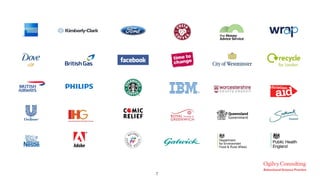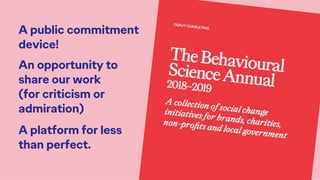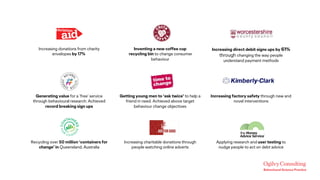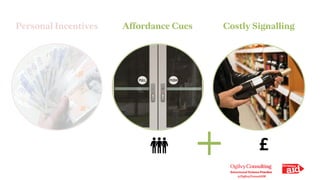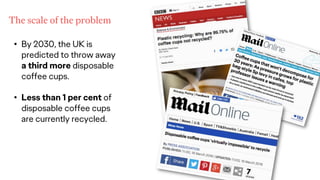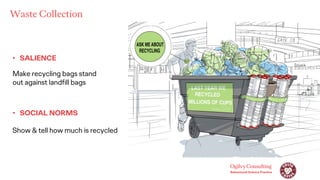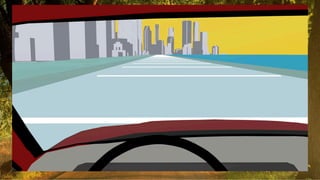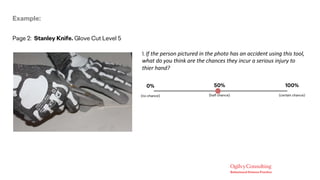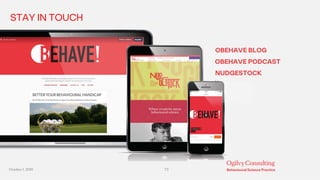What's Next: The Annual
- 1. Powered by What’s Next: The Annual 2019
- 2. Welcome Dayoán Daumont Consulting Partner Ogilvy Consulting Madeleine Croucher Senior Consultant Sam Tatam Consulting Partner Head of Behavioural Science Practice Mike Hughes Consultant Jordan Buck Consultant
- 3. Tell us where you are dialing in from! What’s the weather like in your city?
- 4. Do you want this deck? It will be available for download shortly after the webinar on: slideshare.net/socialogilvy And the recording up on facebook.com/OgilvyConsulting
- 5. 01. Project title/client and challenge The Behavioural Science Annual. A collection of social change initiatives for brands, charities, non-profits and local government 2018-2019
- 6. A LITTLE ABOUT US…
- 7. 7
- 8. October 1, 2019 8 A public commitment device! An opportunity to share our work (for criticism or admiration) A platform for less than perfect.
- 9. October 1, 2019 9 FOUNDATION OF BEHAVIOURAL SCIENCE Fundamental to our way of working are our in-house expert team of behavioural strategists. All of our work is rooted in behavioural thinking and rigorous behavioural research techniques. CREATIVE THINKING Built in the heart of one of the world’s most successful creative networks, our strong creative culture means that our services are bespoke, practical, and suitable for your context. REAL WORLD ITERATION Our team is focused on delivering growth for our clients. To achieve this aim we use our creative and behavioural insights to apply, iterate, and optimise. HOW WE CREATE UNSEEN OPPORTUNITIES
- 10. October 1, 2019 10 FOUNDATION OF BEHAVIOURAL SCIENCE Fundamental to our way of working are our in-house expert team of behavioural strategists. All of our work is rooted in behavioural thinking and rigorous behavioural research techniques. CREATIVE THINKING Built in the heart of one of the world’s most successful creative networks, our strong creative culture means that our services are bespoke, practical, and suitable for your context. REAL WORLD ITERATION Our team is focused on delivering growth for our clients. To achieve this aim we use our creative and behavioural insights to apply, iterate, and optimise. HOW WE CREATE UNSEEN OPPORTUNITIES
- 11. Organisational Transformation Product Development Service Optimisation Communications Strategy Finding unseen opportunities across four key disciplines… CHANGE MANAGEMENT & READINESS HUMAN CENTERED SAFETY UNCONSCIOUS BIAS COPY & CLAIM DEVELOPMENT CAMPAIGN PLANNING MESSAGE TESTING PRODUCT DESIGN PRICING STRATEGY DIGITAL ENGAGEMENT BEHAVIOURAL DESIGN RETAIL DESIGN
- 12. Increasing donations from charity envelopes by 17% Inventing a new coffee cup recycling bin to change consumer behaviour Increasing direct debit signs ups by 61% through changing the way people understand payment methods Generating value for a ‘free’ service through behavioural research. Achieved record breaking sign ups Getting young men to ‘ask twice’ to help a friend in need. Achieved above target behaviour change objectives Increasing factory safety through new and novel interventions Recycling over 50 million ‘containers for change’ in Queensland, Australia Increasing charitable donations through people watching online adverts Applying research and user testing to nudge people to act on debt advice
- 13. Increasing donations from charity envelopes by 17% Inventing a new coffee cup recycling bin to change consumer behaviour Increasing direct debit signs ups by 61% through changing the way people understand payment methods Generating value for a ‘free’ service through behavioural research. Achieved record breaking sign ups Getting young men to ‘ask twice’ to help a friend in need. Achieved above target behaviour change objectives Increasing factory safety through new and novel interventions Recycling over 50 million ‘containers for change’ in Queensland, Australia Increasing charitable donations through people watching online adverts Applying research and user testing to nudge people to act on debt advice
- 14. 14 “How do you increase charity envelope donations?”
- 16. Our challenge 1.Encourage more people to donate. 2. Get people who plan to donate to donate more.
- 17. Unearthing behavioural barriers & drivers to charitable giving
- 18. 18 6 key principles 6 new optimised donation envelopes 200,000 strong RCT
- 20. Our ideas/interventions COGNITIVE EASE Signal it’s an appeal LABOUR ILLUSION Hand delivered stamp SALIENCE Draw attention to gift aid AFFORDANCE CUES Portrait orientation SCARCITY Drive urgency COSTLY SIGNALLING Thicker paper 90gsm -> 150gsm On the back of the envelope
- 21. Our results 90gsm -> 150gsm £ £ £0.34 £0.38 £0.39 £0.39 £0.40 £0.28 £0.18 £- £0.05 £0.10 £0.15 £0.20 £0.25 £0.30 £0.35 £0.40 £0.45 Control Appeal Hand Delivered Stamp Thicker Paper Portrait Oreintation Urgency Salient Gift Aid + 13%+ 10% + 17%+ 14% Amount raised from GA envelopes per envelope distributed
- 22. Personal Incentives Affordance Cues Costly Signalling @OgilvyConsultUK
- 23. Personal Incentives Affordance Cues Costly Signalling @OgilvyConsultUK £
- 24. So... that’s how we’re encouraging the charity sector to test counter-intuitive solutions
- 25. 25 “How do we encourage people to recycle their coffee cups?”
- 27. How many coffee cups are disposed of in the UK every day?
- 28. 7 million!
- 29. • By 2030, the UK is predicted to throw away a third more disposable coffee cups. • Less than 1 per cent of disposable coffee cups are currently recycled. The scale of the problem
- 30. Our challenge GET MORE PEOPLE TO PUT THEIR COFFEE CUPS IN THE RIGHT BIN EVERY TIME, WITH LESS CONTAMINATION
- 31. We identified 5 key barriers Lack of recycling bins & more visibility of cups in landfill bins People don’t see the consequences of contaminating recycling Convenience beats good intentions Don’t know how to recycle them People are dubious of recycling processes
- 33. • FRAMING & PRIMING Prime a recycling mindset over a throw away mindset In Store “Disposable cup” “Recyclable cup”
- 34. • COMMITMENT Make people feel committed to recycling before they’ve done it During use • AFFECT & PERSONIFICATION Create an emotional attachment • COGNITIVE EASE Make it universally understandable
- 35. At disposal
- 36. • SALIENCE New visually salient bins just for coffee cups At disposal • AFFORDANCE CUES Create specific shaped compartments
- 37. • PRIMING Prime people with the cup shaped design At disposal • CONVENIENCE Approachable from all angles
- 38. Waste Collection
- 39. • SOCIAL NORMS Show & tell how much is recycled • SALIENCE Make recycling bags stand out against landfill bags Waste Collection
- 40. UK-wide roll out to city centres, tourist attractions and shopping malls Helping to recycle half a billion coffee cups a year!
- 41. So... that’s how we’re encouraging people to recycle their coffee cups correctly
- 42. 42 “How do we reduce organisational debt by getting people to pay on time?”
- 43. In Worcestershire County Council, many people who receive social care services at home are required to contribute financially to their services. However many invoices go unpaid, resulting in debt for the council and their services overall. Our challenge: How do we nudge users to pay on time, by direct debit, by only optimising the letters and invoices they receive?
- 44. Three key behavioural barriers for our audience to pay Hard to process: Clients can find it hard to read the design and fonts of the letter Information overload Unclear how to make payments Lack of perceived consequence for lack of payment
- 45. Increase the ease to process the information Increase the perceived value of the service Increase the perceived consequences Chunking Labour illusion Loss aversion
- 46. How do we frame direct debit payments as the most attractive way to pay? Asymmetric decoy:
- 47. October 1, 2019 47 If you’re problem could be solved rationally. You probably would have solved it already. Welcome to unseen Opportunities. The Effort Index – ordering the payment methods by behaviours and effort required (through a rating system), nudged users to the least effort (direct debit) option.
- 48. Ogilvy ConsultingPercentage of Direct Debit signups within each condition and phase 0% 1% 2% 3% 4% 5% 6% 7% 8% 9% 10% September October November PERCENTAGEOFPEOPLEWHOSIGNEDUPTODIRECTDEBIT PHASES Condition 1 - Control Condition 2 - Increase Value Condition 3 - Increase consequence Increased direct debit sign ups by 61% (p<.10) compared to the control.
- 49. Reducing the amount of ‘at risk’ debt for Worcestershire County Council. If we were to roll out our direct debit intervention for the domiciliary care service within WCC, we could potentially see a total benefit of approximately: *Calculated at 100 new service users per month. Average invoice value per customer calculated at £305. Forecast calculated at 3.4% mean difference between people signing up to direct debit with Ogilvy’s direct debit intervention, compared to the control. Final figure is calculated assuming 50% of cohort expected to pay at invoice stage, 17% at the 1st reminder stage, and 3% at the 2nd reminder stage. Assumed each individual is on book for a period of 15.7 months before service is cancelled. Individuals who signed up to direct debit are invoiced once per month after signing up. £70,000*over the next 12 months alone.
- 50. October 1, 2019 With the potential to be rolled out nationally to all councils within the Local Government Association And now…
- 51. So... that’s how we’re reducing organisational debt through framing direct debits as the easiest way to pay.
- 52. 01. Project title/client and challenge 01. Project title/client and challenge“How can we make our tissue factories safer?”
- 53. October 1, 2019 53 Our challenge/context Humans evolve slow Factories evolve fast
- 54. 54
- 55. 1/3
- 59. 59
- 61. Photo-Realistic Graphic Image Detailed Outline Minimalist ‘Cues’ Skeleton
- 63. Example: Page 2: Stanley Knife. Glove Cut Level 5 1. If the person pictured in the photo has an accident using this tool, what do you think are the chances they incur a serious injury to thier hand? 0% (no chance) 100% (certain chance) 50% (half chance)
- 64. Example: Page 2: Stanley Knife. Glove Cut Level 5
- 65. Example: Page 2: Automatic Saw. Glove Cut Level 5
- 66. Example: Page 4: Hand Saw. Glove Cut Level 5
- 67. Example: Page 5: Hammer Glove Cut Level 5 Top Side 1. How much faster do you think the person in this video could hit with the hammer whilst remaining at an appropriately low risk of injury? 0.5X (half speed) 2X (double speed) 1X (same speed)
- 69. So… Stay vulnerable and keep an eye out Unseen opportunities are everywhere
- 70. October 1, 2019 70 How to get hold of your copy… ogilvyconsulting.com/our-thinking/
- 71. October 1, 2019 71 One more thing…
- 72. October 1, 2019 72 STAY IN TOUCH OBEHAVE BLOG OBEHAVE PODCAST NUDGESTOCK
- 73. Questions?






